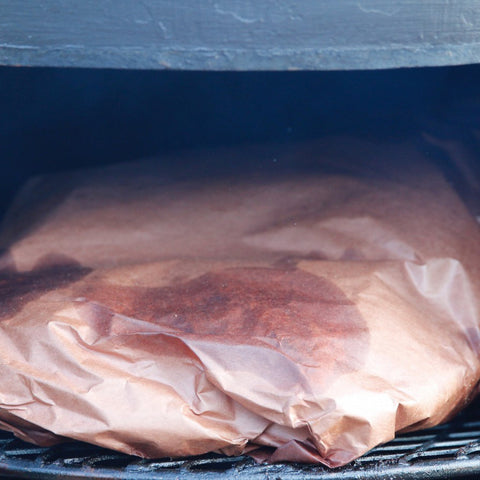What is peach paper?

Forget foil, the hottest BBQ accessory right now is peach paper. Here’s the total breakdown of what exactly it is, and what makes is so special.
BBQ enthusiasts are known to be obsessed with meat quality, smoke flavour and various temp gadgets, but no one expect them to flip out over a roll of paper, yet that’s exactly what is happening in the barbecue world. Orders for this stuff are placed from all over the globe despite completely prohibitive shipping fees, rolls are smuggled back in suitcases with overweight luggage charges just so people can get their hands on this magical wrap. So, with barbecue already being a crazy expensive hobby, why are these people going these exorbitant lengths for a roll of tree pulp?
So what exactly is peach paper?
Here’s when things get tricky. Peach paper is the popular term used for the tinted paper we see used at barbecue joints. However, within the paper industry, “peach paper” refers to a variety of steak paper. Technically speaking, the barbecue pit masters we know, love and are trying to emulate are actually using pink paper. Or more specifically, pink butchers paper. Let me shut down another rumour real quick: neither pink nor peach paper contain any kind of peach essence, it’s simply that the pink colour denotes a natural base whereas white butchers paper is bleached.
Why wrap in the first place?
Pit masters wrap meats either close to or at the end of the cook time, mainly to protect the meat from drying out and losing moisture as it rests and holds at a lower temperature during service. It can also be employed if the cook has gone quicker than expected, to try and retard any further darkening of the bark/exterior crust.
Ok, so why paper not foil?
Wrapping with foil is known as the “Texas crutch”, and is more frequently used for pork ribs rather than beef barbecue. Foil is non-porous (meaning, it doesn’t breathe or allow air in/out), and so when a meat is foiled, any additional smoke cannot penetrate, stopping the smoking process in its tracks. BUT, foil actually reflects the heat back down onto the meat (radiant heat), and also since metal is conductive, it will retain more heat for a lot longer, so whatever you are wrapping will continue to cook to some degree. The biggest downfall of using foil is that when hot meats are wrapped, the steam cannot escape and turns to condensation, which in turn wets the surface of the meat, ruining any crusty bark that has formed during the cook and turning it to mush. Between you and me, let’s just say there is validity to the argument that if you’re foiling your meat longer than you’re smoking it, you’re pretty much just making a roast which is flavored with a hint of smoke, so why even have a damn barbecue? Rant over, the point is that paper solves most of these issues because it allows the steam to escape the parcel and doesn’t make the exterior of the meat soggy, all while keeping the contents protected from the full assault of the smoker. And because it doesn’t retain or reflect heat like foil, you don’t have to compensate for any extra cooking time.
Whats the difference between butchers paper and steak paper, then?
Well, let’s start with the similarities. Both butcher and steak papers have something called “sizing” added, which is basically a treatment that dictates the wet strength of the paper, which as the name suggests, is what keeps it from falling apart when it gets wet. Neither of them have wax coating, it’s an internal treatment to the product that, based on the formula, determines the moisture or vapour barrier of the paper. Butcher paper is designed for same day use – because you buy your piece of meat and carry it home, then discard the paper – so it’s more porous. Steak paper is made for retail display, and therefore is designed to be more robust, and not let as much air reach the product (because it discolours the meat). Steak paper is far denser than butcher, and is manufactured using more hardwood fibres which results in a more rigid product.
- Always use a food grade product. Though you can technically use kraft or any cheaper paper, you have no idea what the composition of the paper is, or if there are certain chemicals used in the manufacturing which may be dangerous. Basically, there may be stuff in there that you just do not want touching your food.
- Food grade doesn’t automatically mean it’s ok to use in the smoker, either. Freezer paper, for example, is designed for use with food, but it has a layer of polyethylene plastic that will melt at a 180f.
- If you do get your hands on some butchers paper, you can actually also use it in the dry ageing process. Just change the wrap every few days.
